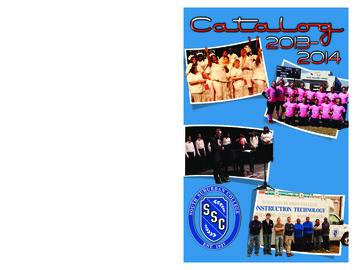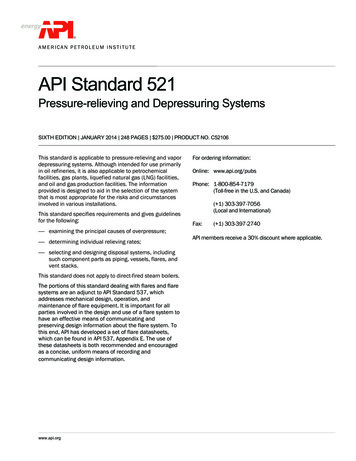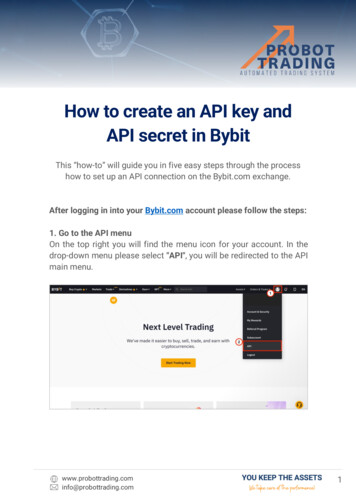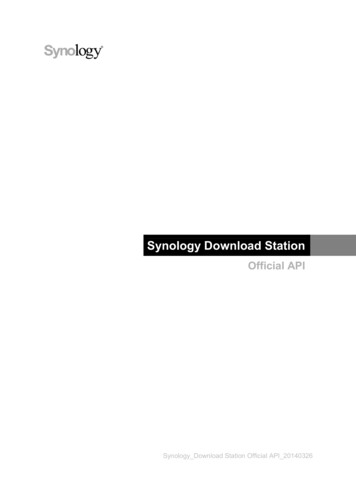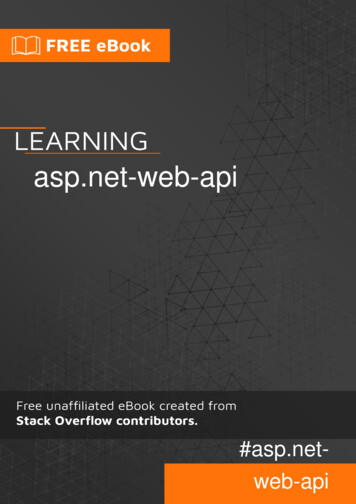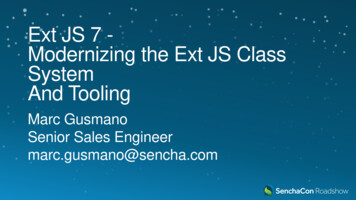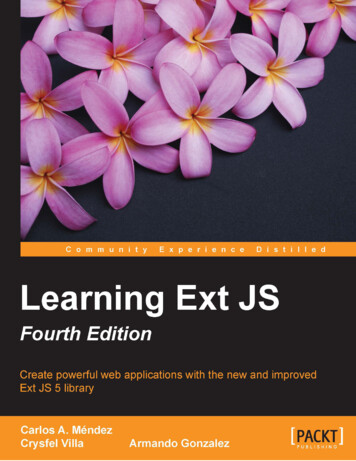
Transcription
Learning Ext JSFourth EditionCreate powerful web applications with the new andimproved Ext JS 5 libraryCarlos A. MéndezCrysfel VillaArmando GonzalezBIRMINGHAM - MUMBAI
Learning Ext JSFourth EditionCopyright 2015 Packt PublishingAll rights reserved. No part of this book may be reproduced, stored in a retrievalsystem, or transmitted in any form or by any means, without the prior writtenpermission of the publisher, except in the case of brief quotations embedded incritical articles or reviews.Every effort has been made in the preparation of this book to ensure the accuracyof the information presented. However, the information contained in this book issold without warranty, either express or implied. Neither the authors, nor PacktPublishing, and its dealers and distributors will be held liable for any damagescaused or alleged to be caused directly or indirectly by this book.Packt Publishing has endeavored to provide trademark information about all of thecompanies and products mentioned in this book by the appropriate use of capitals.However, Packt Publishing cannot guarantee the accuracy of this information.First published: November 2008Second edition: October 2010Third edition: January 2013Fourth edition: July 2015Production reference: 1290715Published by Packt Publishing Ltd.Livery Place35 Livery StreetBirmingham B3 2PB, UK.ISBN 978-1-78439-438-7www.packtpub.com
CreditsAuthorsCopy EditorsCarlos A. MéndezVikrant PhadkeCrysfel VillaAngad SinghArmando GonzalezAmeesha Smith-GreenReviewersDavor LozićProject CoordinatorMilton DsouzaOlivier PonsJuris VecvanagsCommissioning EditorAshwin NairAcquisition EditorShaon BasuContent Development EditorAkashdeep KunduTechnical EditorMenza MathewProofreaderSafis EditingIndexerTejal Daruwale SoniProduction CoordinatorManu JosephCover WorkManu Joseph
About the AuthorsCarlos A. Méndez is a freelance developer and graphic designer living in México,with expertise in web development since 2000 and Windows development since 1998.He has also worked with Ext JS since version 2.x up to the present day. Since 1998,he has developed and designed administrative applications for accounting, payroll,inventory, human resource control, restaurants, hotels, and much more—applicationsthat are in production and up to date.Trying to explore creativity with a deep passion, Carlos has created many Ext JScomponents and VB components for private companies and was also involvedin graphic design, such as illustrations and small animations used for interactivepresentations by some companies in México. He always has a passion for creatingand learning new things on the Web.He is the founder and development manager of the companyadministrationonline.com, which is focused on administrative applications.Carlos is involved in many projects around the world and also provides supportand maintenance to many Ext JS projects ranging from 2.x to 5.x.First of all, I would like to thank my mother and brother for theirsupport and help in realizing this project. Thanks to my best friend,Nacir Garcia Junior, for his support and friendship over these lastyears. Also, thanks to my father and uncles, whose challenges,work pressures, and work and personal knowledge were passed onthrough all these years in matters of design and business logic. Thesehave brought me where I am today. Without all you guys, I wouldnot have been able to accomplish many achievements and goals.Thanks, everybody!
Crysfel Villa is a software engineer with more than 8 years of experience withJavaScript. He started his career as a web developer working with HTML and basicJavaScript in the late 1990s but then started focusing on server-side technologies,such as PHP and Java J2EE.Before he started working with the Ext JS library, he loved to work with MooTools,but in late 2007, he started learning about an awesome new library that wasemerging as an open source project. At that time, version 2.0 of the Ext JS library hadjust been released, and Crysfel started using this new library for medium-to-largeprojects in the agency that he used to work for.In early 2010, he started working as a freelancer. He began training teams on Ext JSfor private companies; writing a blog with tutorials, tips, and tricks; developingcustom components on Ext JS for his clients; and working on open source projects toshare his knowledge with the world.More recently, Crysfel has been getting into new technologies such as Angular JSand React Native. If you want to find out more about his work, you can follow himon Twitter (@crysfel) or download his open source projects from GitHub (crysfel).Writing this book was very hard, especially when you are a busyperson and really like to get involved in exciting things. I want togive special thanks to my wife, Hazel, who supported me in everystep of the process. Without her, this wouldn't have been possible.She read all the scripts before I submitted them. She usually foundsome mistakes or things to clarify. Her work on this projectis priceless.Thanks to my parents and brothers, who used to keep askingme very often about the project and provided me with the moralsupport to work and complete this dream. Also, I want to thank allmy closest friends for the moral support that they gave me. Specialthanks to my best friends, Carlos and Gina, who often pushed me tocontinue working on this project.
About the ReviewersDavor Lozić is a senior software engineer interested in many subjects,especially computer security, algorithms, and data structures. He creates webapplications in CakePHP and Ext JS, and in his spare time, he reads books aboutmodern physics, graph databases like Neo4j, and related subjects. You can check outhis website at http://warriorkitty.com, where you can contact him. He likes catsbecause cats are great! If you would like to talk about any aspect of technology,or if you have great and funny pictures of cats, feel free to contact him.Olivier Pons is a senior developer who has been building websitessince 1997. He's a teacher at the University of Sciences (IUT) of Aix-en-Provence,France. In ISEN (Institut Supérieur de l'Électronique et du Numérique) and Écoled'Ingénieurs des Mines de Gardanne, he teaches state-of-the-art web techniques,such as the MVC fundamentals, Symfony, Wordpress, PHP, HTML, CSS, jQuery,jQuery Mobile, Node.js, AngularJS, Apache, NoSQL, Linux basics, and advancedVIM techniques. He has already done some technical reviews, including PacktPublishing's Ext JS 4 First Look, jQuery Hotshots, jQuery Mobile Web DevelopmentEssentials, Wordpress Complete, and jQuery 2.0 for Designers Beginner's Guide,among others.In 2011, Olivier left a full-time job as a Delphi and PHP developer to concentrate onhis own company, HQF Development (http://hqf.fr). He currently runs a numberof websites, including http://krystallopolis.fr, http://artsgaleries.com,http://www.battlesoop.fr, http://www.livrepizzas.fr, http://www.papdevis.fr, and http://olivierpons.fr, which is his own web developmentblog. He's currently learning Unity and building a game on his own. He works as aconsultant, teacher, and project manager and sometimes helps major companies as asenior/highly skilled developer.
Juris Vecvanags started a career in the IT field in early 90s. At that time, he hadthe chance to work with a broad range of technologies and share his knowledge withFortune 500 companies as well as private and government customers.Before moving to Silicon Valley, he owned a well-established web design start-upin Europe. Juris is currently employed as a solutions architect at Sencha, where hehelps customers write better apps for both desktop and emerging mobile platforms.He contributes to the Ext JS framework as well as dedicates his time to write customcomponents and add new features.When it comes to web technologies, this invaluable experience serves as his groundto be a trusted advisor and competent reviewer. When Juris is away from the office,you can find him speaking at meetups in the San Francisco Bay Area, Chicago, andNew York. Among the topics he covers are Node.js, Ext JS, and Sencha Touch.He is passionate about cutting-edge technologies and everything relatedto JavaScript.
www.PacktPub.comSupport files, eBooks, discount offers, and moreFor support files and downloads related to your book, please visitwww.PacktPub.com.Did you know that Packt offers eBook versions of every book published, with PDFand ePub files available? You can upgrade to the eBook version at www.PacktPub.com and as a print book customer, you are entitled to a discount on the eBook copy.Get in touch with us at service@packtpub.com for more details.At www.PacktPub.com, you can also read a collection of free technical articles,sign up for a range of free newsletters and receive exclusive discounts and offerson Packt books and n/packtlibDo you need instant solutions to your IT questions? PacktLib is Packt's online digitalbook library. Here, you can search, access, and read Packt's entire library of books.Why subscribe? Fully searchable across every book published by PacktCopy and paste, print, and bookmark contentOn demand and accessible via a web browserFree access for Packt account holdersIf you have an account with Packt at www.PacktPub.com, you can use this to accessPacktLib today and view 9 entirely free books. Simply use your login credentials forimmediate access.
Table of ContentsPrefaceChapter 1: An Introduction to Ext JS 5Considering Ext JS for your next projectGetting started with Ext JSDownloading Ext JSSetting up and installing Ext JS 5Sencha Cmdix123455Why so many files and folders?6Looking at the whole pictureOur first programWriting the Ext JS codeAdding interaction to the programTools and editorsXAMPP or WAMPAptanaSencha ArchitectWhat's new in Ext JS 5?Summary891113151516171922Folders that changed in version 5 from previous versions7Chapter 2: The Core Concepts23An explanation of mixinsUsing the mixinConfig property3738The class systemNaming conventionsWriting your first classSimple inheritancePreprocessors and postprocessorsMixing many classes (the use of mixins)[i]242425283134
Table of ContentsConfigurationsStatics methods and properties4043ExplanationThe Singleton classAliasesLoading classes on demandEnabling the loaderWorking with the DOMGetting elementsQuery – how do we find them?DOM manipulation – how do we change it?SummaryChapter 3: Components and LayoutsThe component life cycleThe initialization phaseThe rendering phaseThe destruction phaseThe life cycle in actionAbout containersTypes of containersThe viewportThe panelPanels versus 80The Window componentThe layout systemThe Border layoutThe Fit layoutThe Card layoutThe Accordion layoutThe Anchor layoutMore layoutsComments about using layoutsSummary81828284858687898991Chapter 4: It's All about the DataAjaxPassing parameters to an Ajax requestSetting timeout for Ajax request calls[ ii ]93949899
Table of ContentsModelsMappingsValidatorsCustom field typesRelationships100103105108110Working with the storeAdding new elementsLooping through the records/models in the storeRetrieving the records in the store115116118119Removing recordsRetrieving remote dataAjax proxyReaders120121121124Sending dataSummary127132One-to-many associationsOne-to-one associationsBy index positionFirst and last recordsBy rangeBy IDThe XML reader111113119119119120125Chapter 5: Buttons and ToolbarsEvent-driven developmentCreating a simple buttonSetting icons on buttonsIcon alignment on buttonsHandling button eventsSegmented buttonsAdding menusToolbarsToolbar button groupsThe breadcrumb barHandling selections in the breadcrumb barThe main menu for our applicationSummary[ iii ]133133136138140141142144148150153156158163
Table of ContentsChapter 6: Doing It with Forms165Chapter 7: Give Me the Grid199The form componentThe anatomy of the fieldsThe available fieldsThe TextField classThe number fieldThe ComboBox fieldThe Tag fieldThe Date fieldThe Checkbox and the CheckboxGroup fieldsThe Radio and RadioGroup buttonsThe field containerTriggersSubmitting the dataSummaryThe data connection (models and stores)A basic gridColumnsThe column row numberThe number columnThe template columnThe date columnThe Boolean columnThe check columnThe action columnColumn renderersThe Widget columnSelection modelsGrid ditingExt.grid.plugin.RowEditing[ iv 230230233
Table of ContentsGrid pagingInfinite scrollingSummary236238241Chapter 8: DataViews and Templates243Chapter 9: The Tree Panel257Chapter 10: Architecture277The data connection (model and store)A basic DataViewHandling events in DataViewTemplatesExt.TemplateExt.XTemplateA more complex DataView componentSummaryA basic tree panelThe TreeStoreTree nodesAdding and removing nodesThe check treeThe tree grid 0272275The MVC and MVVM patternsModel-View-Controller (MVC)Model-View-ViewModel (MVVM)Creating our first applicationThe viewsThe controller278278279280282287Listening to eventsOpening modules288291Creating a moduleViewControllerViewModelBinding and data bindingRouter – implementing and usingSummary292296299301311314[v]
Table of ContentsChapter 11: The Look and Feel315Chapter 12: Responsive Configurations and Tablet Support343Chapter 13: From Drawing to Charting363Setting up our environmentThe packages folderVariablesAdvanced themingChanging the component's styleAdding new gradientsStyling the tabsAdding custom fonts to our themeDifferent styles for the same componentSupporting legacy browsersSummaryOverviewNew themesNeptune touch and Crisp touchImplementing responsiveness to the applicationCreating responsivenessInvestigating the outputChecking all panelsSummaryBasic drawingAdding interactionChartsLegendAxisSeriesThemesSeries examplesBar charts (building our first chart)Pie chartsMore chartsIntroducing chart themesEnhancing our application with chartsSummary[ vi 52354361364369373374374375375376376381385386388393
Table of ContentsChapter 14: Finishing the Application395Chapter 15: What's Next?407Index417Preparing for deploymentThe app.json fileThe Sencha commandCustomizing the build.xml fileCompressing the codePackaging and deployingTesting the applicationSummaryForumsResourcesThird-party plugins (commercial)Third-party plugins (free)The futureFinal 4414414415[ vii ]
PrefaceOver the past few years, Ext JS has become a popular and powerful JavaScriptframework for desktop application development. For an Ext JS developer, thelearning curve is not very easy/fast and I have seen cases where developers learningthis framework find it to be a slow process. While writing this book I was thinkingabout the easiest and most comprehensible points so that you can understand thebasics, just as I would have liked to learn about the framework if I was in your place.This book is intended for developers who have the desire to learn and begin usingthis framework for their applications, and also for developers who have not startedusing the current version. It is written as an easy-to-follow guide that will help youunderstand the basics and fundamentals of the framework. If you have experiencewith previous versions of the framework, this book may clear many of your doubtsabout upgrading and how things happen in version 5.x.This book covers all of the basic information you need to know to start developmentwith this nice and powerful framework.What this book coversChapter 1, An Introduction to Ext JS 5, covers an explanation of how to start by gettingthe framework (downloading the file) and setting up the basic requirements youneed in order to begin coding. This chapter also provides an explanation of how theframework is structured, how to set up some required tools, and gives a quick peekat the product, Sencha Architect.Chapter 2, The Core Concepts, is about the framework's class system, and tells you howto use object-oriented programming with Ext JS. Also, this chapter explains how toextend classes, how to inherit properties, and the use of the Loader system in orderto define and require dependencies in a dynamic way.[ ix ]
PrefaceChapter 3, Components and Layouts, explains how components work, how they arecreated, their life cycle, and how to take advantage of all this. Here, you also learnabout types of containers and the layout system, which will help you create amazingUIs with little effort.Chapter 4, It's All about the Data, explains how the framework handles andmanipulates data to display information using data-aware widgets or components.Chapter 5, Buttons and Toolbars, shows you how to make use of component events;listen to events; (mainly) create buttons, toolbars, and menus; and set the most basicconfigurations for these components.Chapter 6, Doing It with Forms, talks about the form component, the available fieldsthat we can use in our forms, and how to collect and submit data.Chapter 7, Give Me the Grid, covers the basics of the most popular component, theGrid panel, in the framework, how to implement it, its column model, and customdata renderers for displaying data. We also see how to listen to events in the Gridpanel and look at some plugins and features (specific capabilities) that can beimplemented in the grid.Chapter 8, DataViews and Templates, explains how to make use of DataViews andtemplates to create data-aware views, implement a nice organization of our data,and set styles and custom logic for the representation of data.Chapter 9, The Tree Panel, covers the use of the tree panel component and itsimplementation. It also explains how to create stores and data for this component.Chapter 10, Architecture, is one of the most important chapters in the book. It showshow to create an application using the MVC and MVVM patterns. This is done inorder to create applications that can be scalable and easy to maintain. The MVVMpattern, which is a powerful pattern for reducing code, is introduced in version 5.Chapter 11, The Look and Feel, demonstrates how to create new themes inside theframework and applications by giving our applications a new look and some colorchanges (themes). Also, you learn how to create specific component-style UIs usingCompass and Sass.Chapter 12, Responsive Configurations and Tablet Support, explains how we can usetouch screen themes and how to set responsive configurations in components inorder to make those components responsive-aware.[x]
PrefaceChapter 13, From Drawing to Charting, talks about the basics of drawing and chartcreation. We see how to create charts by the use of the SVG/VML engines. Thischapter also explains how to add the Chart package to applications and the themeengine introduced in version 5.Chapter 14, Finishing the Application, covers how to prepare our application forthe production environment and deployment, covering the most essential parts forfinal production.Chapter 15, What's Next?, shows you where to get more feedback and resources suchas forums, other useful resources to get information tutorials from, and so on. Thischapter also gives a sneak peek into some useful plugins (commercial and free).What you need for this bookThe web browsers recommended for use are as follows: Google Chrome: http://www.google.com/chrome Firefox: https://www.mozilla.org/en-US/firefox/new/ Firefox for developers: ese browsers come in handy because they come with debugging tools foreasy development.For a web server with PHP support, use this: Xampp: https://www.apachefriends.org/index.htmlFor the database, use the following: MySQL: http://dev.mysql.com/downloads/mysql/ (this also comesbundled in Xampp)For Sencha Cmd and the required tools, use these: Sencha Cmd: http://www.sencha.com/products/sencha-cmd/download Ruby 1.8 or 1.9: http://www.ruby-lang.org/en/downloads/ Sass: http://sass-lang.com/ Compass: http://compass-style.org/[ xi ]
Preface Java RTE (version 1.7.0): loads/java-se-jre-7-download-432155.html Apache ANT: http://ant.apache.org/bindownload.cgi Ext JS (of course): http://www.sencha.com/products/extjs/We will use Ext JS 5.1.1 in this book.Who this book is forIf you are new developers who are beginners in Ext JS, developers familiar with Ext JSwho want to augment the skills of creating better applications, or developers whohaven't yet used version 5.x and want to know more about it, this is the book for you.Users should possess a basic knowledge of HTML/JavaScript/CSS/Sass/Compass,and an understanding of JSON, XML, and any server-side language (such as PHP,ASP, JAVA, and so on) is required.ConventionsIn this book, you will find a number of styles of text that distinguish betweendifferent kinds of information. Here are some examples of these styles, and anexplanation of their meaning.Code words in text are shown as follows: "Inside the app/view folder, we removeall existing files (the initial skeleton), and proceed to create the initial view ourapplication will have."A block of code is set as follows:Ext.define('myApp.model.modulesModel', {extend: 'Ext.data.Model',requires: 'Ext.data.field.Integer'],fields: [[ xii ]
', name: 'description'},'boolean', name: 'allowaccess'},'int', name: 'level'},'string', name: 'moduleType', defaultValue: ''},'string', name: 'moduleAlias', defaultValue: ''},'string', name: 'options'}]});When we wish to draw your attention to a particular part of a code block, therelevant lines or items are set in bold:Ext.define('myApp.store.modulesTreeDs', {extend: 'Ext.data.TreeStore',requires: ,constructor: function(cfg) {var me this;cfg cfg {};me.callParent([Ext.apply({storeId: 'mymodulesTreeDs',autoLoad: true,model: 'myApp.model.modulesModel',proxy: {type: 'ajax',url: 'serverside/data/menu extended.json'}}, cfg)]);}}); Any command-line input or output is written as follows:sencha -sdk /path/to/ext generate app myApp /path/to/myApp[ xiii ]
PrefaceNew terms and important words are shown in bold. Words that you see on thescreen, in menus or dialog boxes for example, appear in the text like this: "Try towrite something in the Customer ID field and you will see that it is read-only."Warnings or important notes appear in a box like this.Tips and tricks appear like this.Reader feedbackFeedback from our readers is always welcome. Let us know what you think aboutthis book—what you liked or may have disliked. Reader feedback is important for usto develop titles that you really get the most out of.To send us general feedback, simply send an e-mail to feedback@packtpub.com,and mention the book title via the subject of your message. If there is a topic that youhave expertise in and you are interested in either writing or contributing to a book,see our author guide on www.packtpub.com/authors.Customer supportNow that you are the proud owner of a Packt book, we have a number of things tohelp you to get the most from your purchase.Downloading the example codeYou can download the example code files for all Packt books you have purchasedfrom your account at http://www.packtpub.com. If you purchased this bookelsewhere, you can visit http://www.packtpub.com/support and register to havethe files e-mailed directly to you.[ xiv ]
PrefaceErrataAlthough we have taken every care to ensure the accuracy of our content,mistakes do happen. If you find a mistake in one of our books—maybe a mistake inthe text or the code—we would be grateful if you would report this to us. By doingso, you can save other readers from frustration and help us improve subsequentversions of this book. If you find any errata, please report them by visiting http://www.packtpub.com/submit-errata, selecting your book, clicking on the erratasubmission form link, and entering the details of your errata. Once your errataare verified, your submission will be accepted and the errata will be uploaded onour website, or added to any list of existing errata, under the Errata section of thattitle. Any existing errata can be viewed by selecting your title from http://www.packtpub.com/support.PiracyPiracy of copyright material on the Internet is an ongoing problem across all media.At Packt, we take the protection of our copyright and licenses very seriously. If youcome across any illegal copies of our works, in any form, on the Internet, pleaseprovide us with the location address or website name immediately so that we canpursue a remedy.Please contact us at copyright@packtpub.com with a link to the suspectedpirated material.We appreciate your help in protecting our authors, and our ability to bring youvaluable content.QuestionsYou can contact us at questions@packtpub.com if you are having a problem withany aspect of the book, and we will do our best to address it.[ xv ]
An Introduction to Ext JS 5When learning a new technology such as Ext JS, some developers face a hard timeto begin with, so this book will give you the best possible way to start to understandthis technology more than any other source. We have to go from the librarydocumentation to blogs and forums looking for answers, trying to figure out how thelibrary and all the components work together. Even though there are tutorials in theofficial learning center, it would be great to have a guide to learn the library from thebasics to a more advanced level; this is the main goal of this book.Ext JS is a state of the art framework to create Rich Internet Applications (RIAs).The framework allows us to create cross-browser applications with a powerful set ofcomponents and widgets. The idea behind the framework is to create user-friendlyapplications in rapid development cycles, facilitate teamwork (MVC or MVVM), andalso have a long-term maintainability.Ext JS is not just a library of widgets anymore; the brand new version is a frameworkfull of new exciting features for us to play with. Some of these features are the newclass system, the loader, the new application package, which defines a standard wayto code our applications, and much more awesome stuff.The company behind the Ext JS library is Sencha Inc. They work on great productsthat are based on web standards. Some of the most famous products that Sencha alsohave are Sencha Touch and Sencha Architect.In this chapter, we will cover the basic concepts of the framework of version 5.You'll learn how to set up the library or SDK and create our first program, get toknow the available tools to write our code, and take a look at some of the newfeatures in Ext JS 5. Considering Ext JS for your next project Getting started with Ext JS—our first program[1]
An Introduction to Ext JS 5 Tools and editors What's new in Ext JS 5?Considering Ext JS for your next projectExt JS is a great library to create RIAs that require a lot of interactivity with the user.If you need complex components to manage your information, then Ext is your bestoption because it contains a lot of widgets such as the grid, forms, trees, panels, anda great data package and class system.Ext JS is best suited for enterprise or intranet applications; it's a great tool to developan entire CRM or ERP software solution. One of the more appealing examples is theDesktop sample index.html). It really looks and feels like a native application running in the browser. Insome cases, this is an advantage because the users already know how to interact withthe components and we can improve the user experience.Ext JS 5 came out with a great tool to create themes and templates in a very simpleway. The framework for creating themes is built on top of Compass and Sass, sowe can modify some variables and properties and in a few minutes we can have acustom template for our Ext JS applications. If we want something more complexor unique, we can modify the original template to suit our needs. This might bemore time-consuming depending on our experience with Compass and Sass.Compass and Sass are extensions for CSS. We can use expressions, conditions,variables, mixins, and many more awesome things to generate well-formatted CSS.You can learn more about Compass on their website at http://compass-style.org/.The new class system allows us to define classes incredibly easily. We can developour application using the object-oriented programming paradigm and take advantageof the single and multiple inheritances. This is a great advantage because we canimplement any of the available patterns such as MVC, MVVM, Observable, or anyother. This will allow us to have a good code structure, which leads us to have easyaccess for maintenance.Another thing to keep in mind is the growing community around the library; thereare lots of people around the world that are working with Ext JS right now. You caneven join the meeting groups that have local reunions frequently to share knowledgeand experiences; I recommend you to look for a group in your city or create one.[2]
Chapter 1The new loader system is a great way to load our modules or classes on demand.We can load only the modules and applications that the user needs just in time.This functionality allows us to bootstrap our application faster by loading onlythe minimal code for our application to work.One more thing to keep in mind is the ability to prepare our code for deployment.We can compress and obfuscate our code for a production environment using theSencha Cmd, a
Before he started working with the Ext JS library, he loved to work with MooTools, but in late 2007, he started learning about an awesome new library that was emerging as an open source project. At that time, version 2.0 of the Ext JS library had just been released, and Crysfel started using this new library for medium-to-large


